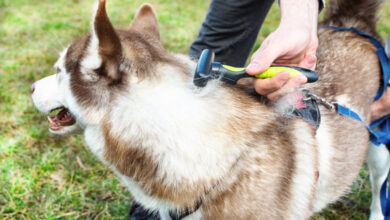Can A Dog Have Only One Puppy

1. Introduction
The question of whether or not a dog can have only one puppy is one that is often asked by pet owners and potential pet owners alike. This article will address this question, as well as other related questions about puppies and their litters. We will look at the factors that affect the number of puppies a dog can have, the average litter size for different breeds of dogs, how many litters a dog can have in its lifetime, how to care for a single puppy, and how to find the right home for your single puppy.
2. What is a Puppy?
A puppy is a young canine, usually between 8 weeks and 6 months old. Puppies are usually born in litters of three or more and are typically cared for by their mother until they reach 8 weeks old. After this time, they are ready to be adopted into their new homes.
3. Can Dogs Have Only One Puppy?
In short, yes – it is possible for a dog to have only one puppy. However, it is not particularly common and there are certain factors that can influence the number of puppies a dog has in its litter.
4. Factors That Affect the Number of Puppies a Dog Has
There are several factors that can affect the number of puppies a dog has in its litter. These include:
• The age and health of the mother – older dogs may have fewer puppies than younger ones;
• The breed of the mother – some breeds tend to produce larger litters than others;
• The size of the mother – larger dogs may have more puppies than smaller ones;
• The nutrition of the mother – if the mother is not receiving adequate nutrition, she may produce fewer puppies;
• The genetics of the parents – some lines may be predisposed to producing larger or smaller litters than others;
• The timing of mating – if mating occurs too close together or too far apart, it can affect the number of puppies produced; and
• The environment – stressors such as noise or overcrowding can reduce litter size.
5. The Average Litter Size for Different Breeds of Dog
The average litter size for different breeds of dogs varies greatly. Smaller breeds such as Chihuahuas typically have litters between 1-3 puppies while larger breeds such as German Shepherds typically have litters between 5-10 puppies. It is important to remember that these averages are just that – averages – and any individual litter may vary significantly from these numbers.
6. How Many Litters Can a Dog Have in Its Lifetime?
The number of litters a dog can have in its lifetime also varies depending on its breed and health status. Smaller breeds tend to have fewer litters than larger breeds and older dogs may not be able to reproduce at all due to age-related infertility issues. Generally speaking, most healthy female dogs can produce between 1-7 litters in their lifetime with an average of 3-4 litters being most common.
7. How to Care for a Single Puppy
Caring for a single puppy requires special attention since it does not have littermates with which to interact and play with. It is important to provide your single puppy with plenty of socialization opportunities so that it grows up to be well adjusted and friendly towards other animals and people. You should also provide your pup with plenty of toys and activities so that it has something fun to do while you’re away from home or busy with other tasks around the house. Additionally, you should make sure you are providing your pup with adequate exercise so that it remains physically fit and healthy throughout its life.
8. How to Find the Right Home for Your Single Puppy
Finding the right home for your single puppy is an important part of being a responsible pet owner. It’s important to make sure you are placing your pup in an environment where it will receive plenty of love, attention, exercise, socialization opportunities, and proper veterinary care throughout its life. Additionally, you should make sure you are placing your pup in an environment where it will be safe from potential hazards such as traffic or other animals that could harm it if given the opportunity. Finally, you should always make sure you are placing your pup in an environment where it will be respected and treated kindly by everyone who interacts with it throughout its life.
9 Conclusion
In conclusion, while it is possible for a dog to have only one puppy in its litter, this is not particularly common due to various factors such as age, breed type, nutrition level, genetics, timing of mating, and environmental stressors which can all affect litter size. Additionally, different breeds tend to produce different sized litters on average with smaller breeds having fewer puppies than larger ones typically do. Furthermore, most healthy female dogs can produce between 1-7 litters in their lifetime depending on their breed type and health status while caring for a single puppy requires special attention due to its lack of littermates with which to interact and play with during development stages . Finally when looking for homes for your single pup ,it’s important that they go into an environment where they will receive plenty love ,attention ,exercise ,socialization opportunities & proper veterinary care .
10 FAQs >
Q1: Can all dogs only have one puppy?
A1: No – some dogs may be able to produce more than one puppy depending on various factors such as age, breed type, nutrition level, genetics, timing of mating, and environmental stressors which can all affect litter size . Additionally different breeds tend to produce different sized litters on average with smaller breeds having fewer puppies than larger ones typically do .
Q2: Is it normal for my dog to only have one puppy ?
A2: Yes – while it is not particularly common ,it is possible for a dog to only have one puppy due various factors such as age ,breed type ,nutrition level ,genetics ,timing of mating & environmental stressors .
Q3: How do I care for my single puppy?
A3: Caring for a single puppy requires special attention since it does not have littermates with which to interact and play with during development stages . It’s important provide your single pup with plenty socialization opportunities so that grows up well adjusted & friendly towards other animals & people . Additionally provide your pup with plenty toys & activities & make sure they get adequate exercise so remain physically fit & healthy .
11 Sources >
• American Kennel Club (AKC). (n/d). “Puppy Development Stages With Growth Charts And Week By Week Guide” Retrieved from https://www.akc.org/expert-advice/puppy-care/puppy-development-stages/
• American Veterinary Medical Association (AVMA). (2019). “Litter Size In Dogs” Retrieved from https://www.avma.org/resources/pet-owners/petcare/litter-size-in-dogs
• PetMD (n/d). “How Many Litters Can A Dog Have In Its Lifetime?” Retrieved from https://www.petmd.com/dog/care/how-many-litters-can-dog-have-its-lifetime




